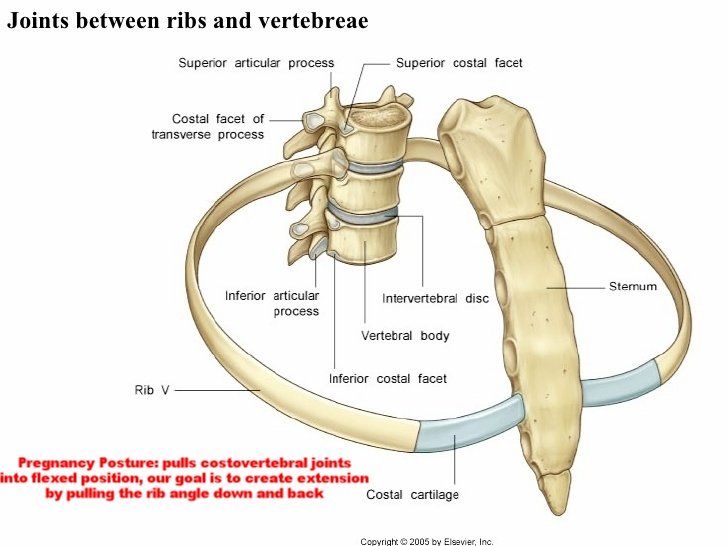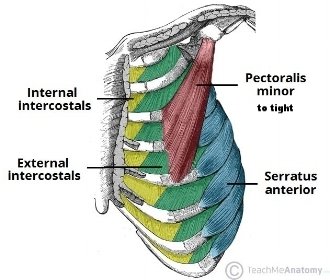Rib Pain
During pregnancy your ribs can be the source of some serious pain. This is often due to your baby pushing on your rib cage and poor postures you often find yourself in during pregnancy. The pain may be mild or it may be pretty severe. Typically, this pain is felt most intensely while sitting, because when you sit your body is being pulled into that forward posture or slump position. It is easy to fall into these poor postures during pregnancy; as your belly grows your shoulder blades get pulled forward along with it. Your upper back also rounds forward due to the excessive weight of your breast tissue as well as the baby bump that is hanging out in front.
Anatomy (see images below):
The rib cage makes a ring shape. The costcovertebral joints connect each of your ribs to your spine in two places.
If your back is rounded, this can cause your ribs to pop up and outward.
The pectoralis minor and major attach your shoulder blades to your ribs.
When you get into that slumped position, this causes those muscles to become very tight. We need to loosen them up in order to get relief.
The muscles in your back (Middle Trapezius, Lower Trapezius, Latissimus Dorsi, Serratus Anterior, Paraspinals, Multifidus) aka your postural muscles, need to be strengthened in order to be able to hold your body in proper postures. Strengthening these muscles will in turn help to decrease pressure on the ribs.
The shape of your diaphragm is also really important for the function and structure of the ribs. And keeping the ribs pain free. To maintain our diaphragm shape we have to USE it. Inhale and EXHALE fully. Exhaling pulls the ribs down and in when a baby and your bump is pushing them up and out. Exhales should be performed from the bottom up (your pelvic floor) and should be LONG, FULL exhales. When many pregnant mamas exhale, it is often just a short and shallow exhale!
How to Fix:
When your back becomes rounded and your ribs begin to pop up and outward, the goal is to pull them down and back through movement and exercise. In order to do this you first need to get your ribs moving, and then you need to loosen up the front or the anterior chest muscles to allow the ribs to sit in their correct position.
Incorporating proper diaphragmatic breathing into your daily routine is a great way to create movement in the costovertebral joints. When joints are stiff, they often get stuck and that is what causes pain. On the contrary, when joints are able to move, synovial fluid helps to pump healthy cells into that area, keeping them happy and pain free.
And then the most important piece is to strengthen those postural muscles in your back so that they can also do their job. If you are feeling this pain now, I would highly recommend that you start taking action, especially if you are planning on nursing because postpartum life does not become easier!
Step 1: Creating Specific Movement in the Ribs (see IGTV)
Chest Opener with Chair
Side Lying Thoracic Rotation
Cat/Cow
Side Lying Rib Opening: also combine with soft tissue mobilization
Step 2: Loosening the pectoralis and anterior chest structures
Pectoralis Stretch: perform at 60/90/120* on both sides
Step 3: Diaphragmatic Breathing
Make your diaphragm fight for involvement in breath. During pregnancy women often breathe in their chest, when breath is just in your chest your ribs don’t move up and outward. The best breathing is 360 degree breathing. The front area usually moves much easier since breath goes to the area of ease. To fight this we want to focus on your back body breath - pulling breath into your bra line. You want to get breath into your back, then both sides of your ribs are able to move up and outward.
Step 4: Stabilization Exercises
DB Bent Over Reverse Flys
DB Bent Over Rows
DB Side Lying External Rotation
RB Pull Aparts
Other tips to make your ribs feel better:
Taking a hot shower and letting the water run along your backside.
Avoid sitting for long periods of time.
If you do have to sit for work, take breaks often and try some of the stretches in step one.
Avoid hunching over while standing
Eat an anti-inflammatory diet - lots of fruits, vegetables, beans, nuts, etc. Try to avoid processed foods, refined grains, sugary drinks, etc.
Seek immediate medical attention if you are experiencing severe, sudden onset rib pain and have the following symptoms: dizziness, seeing spotting or floaters in your eye, bleeding, headaches, nausea and vomiting. This could be a sign of gallstones, heartburn, or liver failure.


